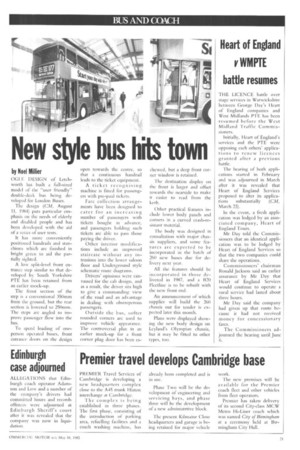News e bus hits town
Page 23

If you've noticed an error in this article please click here to report it so we can fix it.
by Noel Millier
OGLE DESIGN of Letchworth has built a lull-sized model of the "user Friendly" double-deck bus being developed for London Buses. The design (CM, August 11, 1984) puts particular emphasis on the needs of elderly and disabled people and has been developed with the aid of a series of user tests.
It has more conveniently positioned handrails and stanchions which are finished in bright green to aid the partially sighted.
A low split-level front entrance step similar to that developed by South Yorkshire PTE has been retained from an earlier mock-up.
The front section of the step is a conventional 350mm from the ground, but the rear section is lowered to 250mm. The steps are angled to improve passenger flow into the bus. To speed loading of oneperson operated buses, front entrance doors on the design open towards the centre, so that a continuous handrail leads to the ticket equipment. A ticket recognising machine is fitted for passengers with pre-paid tickets. Fare collection arrangements have been designed to cater for an increasing number of passengers with tickets bought in advance, and passengers holding such tickets arc able to pass those paying the driver. Other interior modificadons include an improved staircase without any intrusions into the lower saloon floor and Underground style schematic route diagrams. Drivers' opinions were canvassed for the cab design, and as a result, the driver sits high to give a commanding view of the road and an advantage in dealing with obstreperous passengers. Outside the bus, softer rounded corners arc used to improve vehicle appearance. The controversal plan in an earlier mock-up for a front corner plug door has been es
chewed, but a deep front corner window is retained.
The destination display on the front is larger and offset towards the nearside to make it easier to read from the kerb.
Other practicalfeatures include lower body panels and corners in a curved crash-resistant material.
The body was designed in consultation with major chassis suppliers, and some features are expected to be incorporated in the batch of 260 new buses due for delivery next year.
All the features should be incorporated in those delivered in 1987, and a B20 Heedine is to be rebuilt with the new front end.
An announcement of which supplier will build the 260 chassis out for tender is expected later this month.
Plans were displayed showing the new body design on Leyland's Olympian chassis, but it may be fitted to other types, too.




















































































